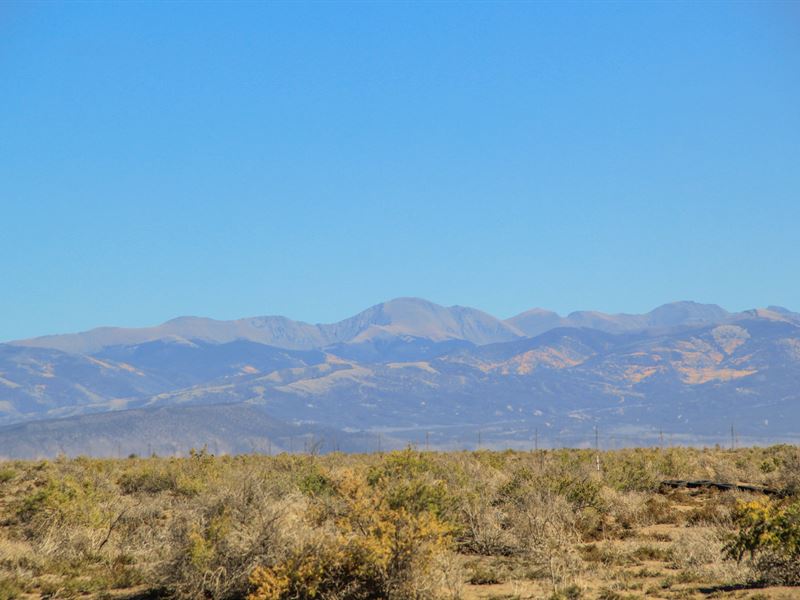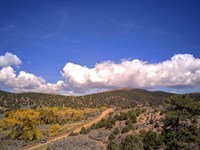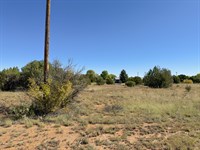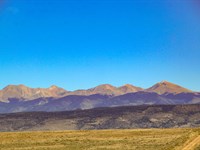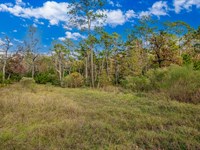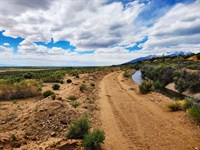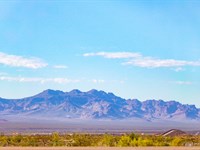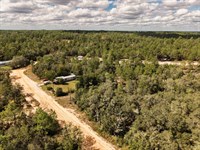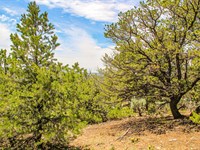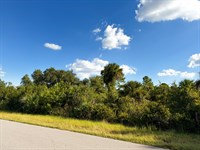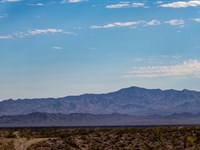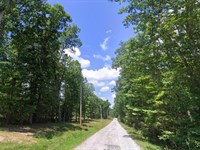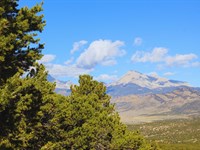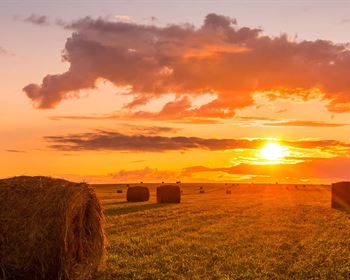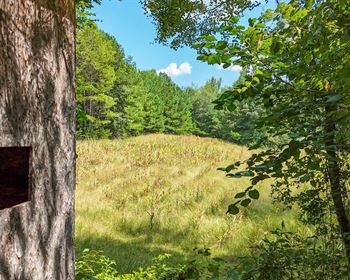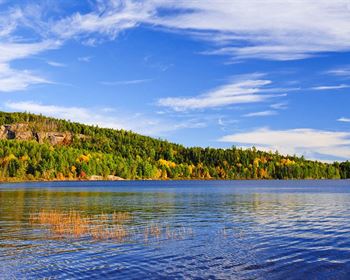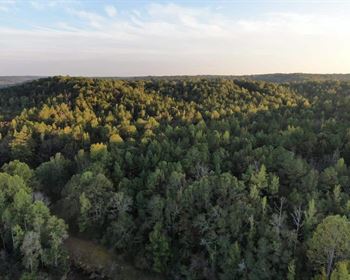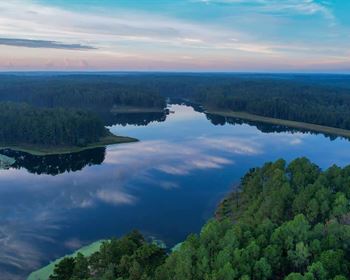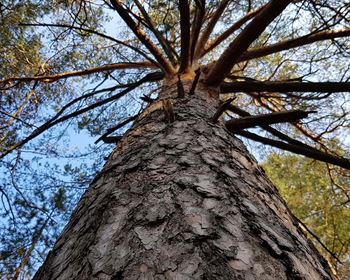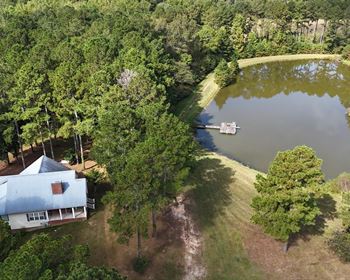Mountain View RV or Build Lot
Alamosa, CO 81101
Alamosa County, Colorado
Land Description
This land sits in the San Luis Valley with the Sangre de Cristo Mountains rising to the east and the San Juan range visible to the west. The terrain is open and level, covered in native grasses and high desert vegetation-perfect for anyone who wants room to spread out and build exactly what they envision. Power lines run nearby along maintained dirt roads, making this an accessible spot whether you're planning to put down roots or set up a base camp for exploring the area.
The Alamosa National Wildlife Refuge is just minutes away, offering 12,000 acres of protected wetlands where sandhill cranes gather by the thousands during migration season. You can fish, birdwatch, and hike the trails that wind through this remarkable landscape. Beyond the refuge, you're positioned for adventures in Great Sand Dunes National Park to the northeast, where 750-Foot dunes create the tallest sand mountains in North America. The town of Alamosa provides all necessary services and sits close enough for convenient supply runs without crowding your privacy.
This property gives you the freedom to build a traditional home, set up a manufactured home, or get a six-month RV permit once you install a septic system. With no HOA restrictions and zoning that allows tiny homes down to 500 square feet, you can design your Colorado experience your own way. The wide-open spaces, mountain views, and abundant wildlife make this land ideal for anyone ready to claim their piece of the high country and live on their own terms.
We are open to owner financing as well - here is what that would look like:
- Total Money Down: $599($349 downpayment + $250 closing cost)
- Monthly: $250/Month for 72 months
See Info below.
- Subdivision: Deer Valley Meadows
- State: Co
- County: Alamosa
- Zip:
- Size: 2.59
- Parcel: 12 + 13
- Legal Description: Deer Valley Meadows Lot 12 + 13 Blk H Unit 3
- Approximate Lat/Long Coordinates:
37.4606, -105.6805 W
37.461, -105.6801 N
37.4604, -105.6793 E
37.46, -105.6797 S
- Annual Taxes: Approximately 28.86/Year
- Zoning: Residential Manufactured Home (Rmh)
--- Residential homes allowed
--- Double wide Mobile homes allowed
--- Camping: 6-month RV permits available (requires a septic system)
--- Tiny homes allowed. Minimum build is 500sq ft
- Hoa/Poa: No
- Improvements: None
- Access: Garnet Ln. and Agate Dr.
- Water: Would require well or alternative.
- Sewer: Would require septic system.
- Utilities: Contact Xcel Energy or use alternative power.
Information presented in this listing is deemed accurate but is not guaranteed. Buyers are advised to conduct their own due diligence and verify all details independently.
---
Location And Setting Overview
- Valley Floor Living at Its Finest: Your 2.59 acres of pristine Colorado high desert sits perfectly positioned on the valley floor of the San Luis Valley, one of the largest and most dramatic alpine valleys in North America. At 7,540 feet elevation, this property offers the ideal combination of accessible mountain living without the extreme elevation challenges of higher properties. The terrain spreads level and open before you, covered in hardy native grasses, sage, and rabbitbrush that have thrived here for thousands of years. Unlike properties on steep hillsides or rocky outcroppings that require expensive grading and foundation work, your land provides multiple building sites with minimal site preparation needed. The gentle, flat topography means you can position your home or cabin anywhere on the property to capture the best views, maximize solar exposure, or create privacy from neighboring parcels.
- Sangre de Cristo Mountain Views: Look east from your property and the massive wall of the Sangre de Cristo Range dominates the horizon in spectacular fashion. These ancient peaks rise over 7,000 feet from the valley floor, creating one of the most dramatic vertical reliefs in the entire Rocky Mountain system. Mount Blanca, at 14,345 feet elevation and Colorado's fourth-highest peak, stands as the undisputed monarch of this range, visible from your property as a massive pyramid of rock and permanent snowfields. The mountain's Native American name, Sisnaajini, means Sacred Mountain of the East to the Navajo people, and one look at this magnificent peak explains why ancient peoples held it in such reverence. During sunrise, alpenglow transforms these mountains into brilliant shades of pink, orange, and crimson, creating daily light shows that rival anything you'll see in nature. Winter brings heavy snowfall to the high peaks, painting them brilliant white against Colorado's famous blue skies, while summer reveals the complex geology of gray granite, red sandstone, and green alpine meadows.
- San Juan Range on the Western Horizon: Turn your gaze west and another spectacular mountain range frames your property. The San Juan Mountains, though more distant than the Sangre de Cristos, form an equally impressive backdrop stretching across the western sky. These volcanic peaks represent some of Colorado's most rugged and remote wilderness, with numerous peaks exceeding 14,000 feet including Uncompahgre Peak, Wetterhorn, and the challenging Needle Mountains. The San Juans receive some of Colorado's heaviest snowfall, feeding the Rio Grande River that flows through the valley and creating the lush wetlands that make this area such incredible wildlife habitat. On clear days, you can watch weather systems move across these distant peaks, with afternoon thunderstorms building over the high country before occasionally sweeping across the valley in dramatic displays of lightning and brief but intense rainfall.
- Deer Valley Meadows Subdivision Character: Your property sits within the Deer Valley Meadows subdivision, a rural residential community that attracts independent-minded landowners seeking space, freedom, and the authentic Colorado mountain experience. Unlike urban subdivisions with strict architectural controls and mandatory homeowner associations, Deer Valley Meadows embraces the Western tradition of individual liberty and property rights. Your neighbors here represent a diverse mix of working ranchers, retirees building dream mountain cabins, off-grid homesteaders, and families seeking clean air and wide-open spaces for their children to explore. The subdivision maintains a balance between community and privacy, with parcels large enough that you won't feel crowded but close enough that you can build relationships with like-minded neighbors if you choose. Maintained dirt roads provide year-round access throughout the subdivision, with county grading keeping the main routes passable even after storms.
- Strategic Location Between Natural Treasures: Your property occupies a strategic position between some of Colorado's most remarkable natural attractions. Just 15 minutes north, the Alamosa National Wildlife Refuge encompasses 12,026 acres of protected wetlands, riparian corridors, and upland habitat along the Rio Grande River. This federal refuge, established in 1963, provides critical habitat for over 200 species of birds and serves as a crucial stopover for thousands of migrating sandhill cranes each spring and fall. The refuge features several hiking trails, a wildlife drive accessible by vehicle, and observation platforms where you can watch birdlife without disturbing the natural environment. Thirty miles northeast of your property, Great Sand Dunes National Park and Preserve protects the tallest sand dunes in North America, rising up to 750 feet from the valley floor in surreal formations that seem transported from the Sahara Desert. These dunes, combined with seasonal Medano Creek flowing at their base during snowmelt, create a unique recreation destination for sandboarding, sand sledding, hiking, and photography.
- Alamosa Commercial Hub: The town of Alamosa, located approximately 20 minutes northwest of your property, serves as the commercial and cultural center of the San Luis Valley. With a population approaching 10,000 residents, Alamosa provides all the essential services and amenities you need without the congestion, crime, and cost of Colorado's Front Range cities. Here you'll find major grocery stores including Walmart Supercenter, Safeway, and City Market, along with hardware stores, restaurants, medical facilities, and banking services. The San Luis Valley Regional Medical Center in Alamosa offers full emergency room services, surgical capabilities, and specialized medical care, providing peace of mind that quality healthcare sits within easy reach. Adams State University brings cultural enrichment to the valley through concerts, theater performances, athletic events, and educational opportunities. The downtown historic district features local restaurants serving everything from traditional New Mexican cuisine to craft beer and farm-to-table dining, while local shops offer unique Colorado-made gifts and outdoor gear.
- Rio Grande River Corridor: Eight miles west of your property, the mighty Rio Grande River flows through the heart of the San Luis Valley on its 1,896-Mile journey from the Colorado mountains to the Gulf of Mexico. This legendary river, named by Spanish explorers in the 1600S, has served as the lifeblood of the valley for centuries, providing irrigation water for agriculture and critical riparian habitat for wildlife. The Rio Grande corridor through Alamosa County supports cottonwood galleries, willow thickets, and wetland vegetation that attract incredible concentrations of wildlife year-round. Bald eagles winter along the river, fishing for trout in open water while most of the valley freezes. Great blue herons stalk the shallows during summer, while beavers engineer complex dam systems in tributary streams. Fishing along the Rio Grande produces rainbow trout, brown trout, and the native Rio Grande cutthroat trout, a rare subspecies found only in this watershed.
- Climate and Growing Conditions: At 7,540 feet elevation, your property enjoys a high-altitude climate that combines abundant sunshine, low humidity, and four distinct seasons. The San Luis Valley receives an average of 320 sunny days per year, more than San Diego, California, and among the highest solar radiation levels in the continental United States. This intense sunlight, combined with thin mountain air, makes the valley ideal for solar power generation and passive solar home design. Summer temperatures typically reach the comfortable mid-70s to low 80s Fahrenheit during the day, with cool nights dropping into the 40s that make sleeping comfortable without air conditioning. Winter brings cold temperatures with daytime highs often in the 30s and overnight lows dropping below zero during the coldest periods, but the abundant sunshine means that snow melts quickly from dark surfaces and roads. Annual precipitation averages only 7-8 inches on the valley floor, making this a true high desert environment where drought-resistant native vegetation thrives.
- Access and Infrastructure: Your property fronts on maintained subdivision roads with access from both Garnet Lane and Agate Drive, providing flexibility for driveway placement and excellent access regardless of weather conditions. These dirt roads receive regular grading from Alamosa County, keeping them passable year-round for standard vehicles, though a truck or SUV with good clearance proves more comfortable during muddy spring conditions or after heavy snows. Power lines run along nearby roads, with Xcel Energy providing electrical service to properties throughout the subdivision for those who prefer grid connection. Many landowners, however, choose to develop their properties entirely off-grid using solar power, wind generation, or generator systems, taking advantage of the valley's exceptional renewable energy resources and avoiding monthly utility bills. Cellular phone coverage from major carriers provides reliable communication throughout most of the subdivision, while satellite internet services including Starlink deliver high-speed broadband to even the most remote parcels.
Recreational Opportunities
- Great Sand Dunes National Park Adventures: Just 30 miles from your property, Great Sand Dunes National Park and Preserve protects one of Colorado's most unique and spectacular natural wonders. The dunes, rising up to 750 feet from the valley floor, represent the tallest sand dunes in North America and create an otherworldly landscape that seems impossibly out of place in the Rocky Mountains. These massive sand formations accumulated over hundreds of thousands of years as prevailing winds carried sand particles from the San Luis Valley floor and deposited them against the Sangre de Cristo Mountains, building the dunes grain by grain into their current impressive heights. Visitors to the park can hike up the dunes, feeling their calf muscles burn with each step in the soft sand, until reaching the ridgelines where spectacular views stretch across the entire San Luis Valley with mountain ranges visible in every direction. During late spring and early summer, Medano Creek flows at the base of the dunes, fed by snowmelt from the high peaks, creating a temporary beach where families play in the shallow water while surrounded by towering sand mountains.
- Sandboarding and Sand Sledding: The Great Sand Dunes provide excellent terrain for sandboarding and sand sledding, activities unique to this remarkable landscape. Several shops in Alamosa and at the park entrance rent specialized sand sleds and boards designed with slick bottoms that glide over the sand, allowing you to ride down the steep dune faces at thrilling speeds. Unlike snow skiing where crashes can be painful, wiping out on the sand dunes results in soft landings, making this an excellent family activity where kids and adults can push their limits without serious injury risk. The sand reaches surprisingly high temperatures during summer afternoons, sometimes exceeding 140 degrees Fahrenheit on the surface, so most visitors prefer to tackle the dunes during morning hours or bring shoes to protect feet during the hottest months. Spring and fall provide ideal temperatures for dune exploration, with comfortable conditions that allow hours of hiking, playing, and sliding without overheating.
- Alamosa National Wildlife Refuge Birding: Living just 15 minutes from Alamosa National Wildlife Refuge means you enjoy year-round access to one of Colorado's premier birding destinations. The refuge's 12,026 acres encompass diverse habitats including cattail marshes, wet meadows, riparian corridors along the Rio Grande River, and upland areas covered in greasewood and saltbush. This habitat diversity attracts an incredible variety of bird species, with over 200 species documented on the refuge throughout the year. The refuge's crown jewel occurs twice annually during spring and fall migrations, when tens of thousands of sandhill cranes stage in the wetlands during their journeys between summer breeding grounds in Alaska and Siberia and winter territories in New Mexico and Texas. These magnificent birds, standing four feet tall with seven-foot wingspans, create an unforgettable spectacle as massive flocks circle overhead, their distinctive bugling calls echoing across the valley during early morning and evening hours.
- Wildlife Drive and Hiking Trails: The refuge features a Wildlife Drive accessible by vehicle, allowing you to tour the wetlands from the comfort of your car while viewing wildlife through binoculars or spotting scopes. This seven-mile loop road winds through prime habitat where you might see great blue herons stalking fish in shallow water, double-crested cormorants diving for prey, American white pelicans riding thermals overhead, or northern harriers hunting low over the marshes with their distinctive tilting flight pattern. Several hiking trails provide more intimate wildlife viewing opportunities for those willing to explore on foot. The Rio Grande Nature Trail stretches 1.8 miles through riparian forest along the river, with cottonwood trees providing shade while songbirds flit through the branches overhead. This trail closes from April 15 through September 1 each year to protect nesting southwestern willow flycatchers, a federally endangered species that breeds in the dense willow thickets found along the river corridor.
- Fishing the Valley Waters: Anglers living in the San Luis Valley enjoy access to diverse fishing opportunities ranging from small mountain streams to large reservoirs. The Rio Grande River, flowing just eight miles from your property, produces quality trout fishing for rainbow trout, brown trout, and the rare Rio Grande cutthroat trout, Colorado's only native trout species. Fishing the Rio Grande requires reading the water to identify likely holding spots behind rocks, in deep pools, and along undercut banks where trout wait to ambush passing insects and baitfish. Fly fishing proves most effective during spring and summer when mayfly and caddisfly hatches bring trout to the surface in spectacular feeding frenzies. Mountain Home Reservoir, located 45 minutes north of your property, provides excellent lake fishing from both boats and shore, with regular stocking programs maintaining populations of rainbow trout and brown trout that grow to impressive sizes feeding on abundant aquatic insects and small fish in the fertile mountain water.
- Hiking and Backpacking Access: The Sangre de Cristo Mountains rising east of the valley provide unlimited hiking and backpacking opportunities ranging from easy nature walks to challenging multi-day wilderness expeditions. Dozens of trailheads access the Sangre de Cristo Wilderness, a 220,000-Acre federally designated wilderness area where motorized vehicles and mountain bikes are prohibited, preserving the backcountry experience for hikers, backpackers, and horseback riders. Day hikes from valley trailheads climb through pinyon-juniper woodlands into ponderosa pine forests, then continue ascending through aspen groves and subalpine fir forests before emerging above treeline into the stark beauty of alpine tundra where only hardy grasses and wildflowers survive the harsh conditions. Hikers who reach these high elevations enjoy spectacular views across the entire San Luis Valley, with the valley floor visible 7,000 feet below and mountain ranges stretching to the horizon in every direction.
- Fourteener Access: Colorado's famous fourteeners, mountains exceeding 14,000 feet elevation, attract climbers from around the world seeking the challenge and accomplishment of reaching these rarified summits. Your Alamosa County property provides access to several fourteeners within 90 minutes' drive, with Mount Blanca being the closest and most visible from your land. Blanca Peak, at 14,345 feet, ranks as Colorado's fourth-highest mountain and features multiple climbing routes ranging from non-technical hiking trails to challenging scrambles over loose rock and steep scree slopes. The standard route follows the Blanca Peak trail from the Lake Como trailhead, climbing steadily through alpine basins and up rocky slopes before reaching the summit where views stretch across southern Colorado into New Mexico. Experienced mountaineers can extend their Blanca adventure by traversing to adjacent peaks including Little Bear Peak and Ellingwood Point, creating a challenging ridge walk that tests endurance and technical climbing skills.
- Mountain Biking Trails: Mountain bikers exploring the San Luis Valley find diverse terrain suitable for all skill levels. The valley floor itself provides excellent gravel riding on maintained dirt roads that wind through working ranchland, offering big sky views and opportunities to spot wildlife while logging miles on quiet routes with minimal vehicle traffic. More technical riders head into the foothills and mountains where singletrack trails climb through forests and meadows, with steep ascents rewarded by thrilling downhill sections that test bike handling skills. The Rainbow Trail, a 100-Mile path traversing the Sangre de Cristo Range, provides multi-day bikepacking adventures for riders seeking backcountry solitude and spectacular scenery. This trail, originally constructed by the Civilian Conservation Corps in the 1930S, connects numerous drainages and provides access to alpine lakes, high passes, and remote wilderness areas rarely visited except by the most dedicated outdoor enthusiasts.
- Off-Highway Vehicle Exploration: The San Luis Valley and surrounding national forest lands offer extensive off-highway vehicle opportunities for ATV and side-by-side enthusiasts. Thousands of miles of designated OHV trails wind through public lands, ranging from easy two-track roads suitable for beginners to challenging technical trails that require advanced driving skills and capable machines. Many OHV routes climb from the valley floor into the mountains, following old mining roads and logging tracks that access high alpine basins where wildflowers bloom in summer and wildlife viewing opportunities abound. Popular OHV destinations within 90 minutes of your property include the extensive trail system near Creede, the alpine routes in the La Garita Wilderness area, and the network of forest roads exploring the western slopes of the Sangre de Cristo Mountains where remnants of historic mining operations provide glimpses into Colorado's frontier past.
Wildlife And Hunting
- Mule Deer Populations: Mule deer thrive throughout Alamosa County and the surrounding San Luis Valley, with healthy populations providing excellent viewing opportunities and quality hunting experiences. These large-eared deer, named for their distinctive mule-like ears that rotate independently to pinpoint sounds, have adapted perfectly to the high desert valley environment where they browse on sagebrush, bitterbrush, and native grasses. During summer months, mule deer scatter across the valley floor and foothills, with bucks growing impressive antlers through late summer before shedding the velvet in early fall. Come winter, deer concentrate in lower elevations where snow depths remain manageable and south-facing slopes provide access to food when deeper snow blankets north-facing terrain. From your property, you'll regularly see mule deer crossing the open valley floor during dawn and dusk hours, with does often traveling in small family groups accompanied by fawns, while mature bucks tend to remain solitary or form bachelor groups outside the fall breeding season.
- Elk Herds and Migration: Rocky Mountain elk, North America's largest cervid species after moose, inhabit the mountains surrounding the San Luis Valley in impressive numbers. The Trinchera elk herd, one of Colorado's most productive elk populations, summers in the high country of the Sangre de Cristo Mountains before migrating to lower elevations during winter months. These massive animals, with mature bulls weighing up to 700 pounds and standing five feet tall at the shoulder, create unforgettable wildlife encounters when spotted grazing in mountain meadows or heard bugling during the September rut. The distinctive bugling call of bull elk during breeding season carries for miles across the valley on calm mornings, a haunting sound that epitomizes the wild character of Colorado's mountain country. Elk migrate through the valley and surrounding foothills during spring and fall, following ancient routes connecting summer and winter ranges, and patient observers glassing the foothills from valley vantage points often spot herds numbering dozens or even hundreds of animals.
- Pronghorn Antelope: Pronghorn antelope, North America's fastest land animal capable of sustained speeds exceeding 55 miles per hour, inhabit the open grasslands and sagebrush flats throughout the San Luis Valley. These unique animals, more closely related to giraffes than true antelope, evolved on the Great Plains over millions of years and represent a living link to the Pleistocene epoch when cheetahs and other large predators roamed North America. Pronghorn on the valley floor live in small herds, with dominant bucks defending harems of does during the fall breeding season while younger males form bachelor groups. Their incredible eyesight, equivalent to humans using 8-power binoculars, allows them to detect movement from miles away, making them challenging quarry for hunters who must employ careful stalking techniques or long-range shooting skills to approach within effective range. Watching pronghorn run across open flats demonstrates the grace and power of these animals, as they seem to float over the sagebrush with effortless speed that leaves observers in awe.
- Sandhill Crane Migrations: Twice each year, the San Luis Valley hosts one of North America's most spectacular wildlife events as tens of thousands of sandhill cranes stage in valley wetlands during spring and fall migrations. These ancient birds, whose fossil record extends back over 10 million years making them among the oldest bird species on Earth, travel thousands of miles between breeding grounds in Alaska, Siberia, and Canada and wintering areas in New Mexico, Texas, and Mexico. During March and October, valley skies fill with massive flocks of cranes spiraling upward on thermal updrafts, their distinctive rolling bugle calls creating a prehistoric soundscape as waves of birds pass overhead. The cranes primarily concentrate at Monte Vista and Alamosa National Wildlife Refuges, where managed wetlands provide crucial feeding and resting habitat, but they range widely across the valley to feed in agricultural fields and natural wet meadows where they probe the ground with their long bills searching for waste grain, insects, and plant tubers that fuel their long-distance journeys.
- Predators and Raptors: The San Luis Valley's abundant prey base supports healthy populations of predators that play crucial roles in ecosystem health. Coyotes, the West's signature predator, inhabit every corner of the valley from the Rio Grande riparian zone to the highest mountain passes. These adaptable canines hunt rabbits, ground squirrels, mice, and voles while also scavenging carrion and occasionally taking larger prey like fawns or elk calves. Their evening songs, starting with lone howls that quickly build into a chorus of yips and yaps, provide nightly entertainment and connection to the wild character of the valley. Golden eagles, massive raptors with seven-foot wingspans and talons capable of crushing prey with over 400 pounds of pressure, hunt the valley floor for rabbits and prairie dogs while also taking marmots and ground squirrels in higher elevations. These magnificent birds build enormous stick nests on cliff faces and large trees, returning to the same nest sites year after year and adding more material until nests reach impressive sizes exceeding five feet across.
- Small Game Abundance: The valley and surrounding foothills provide excellent small game hunting opportunities for cottontail rabbits, jackrabbits, and game birds. Desert cottontails inhabit brush-covered areas throughout the valley, using their camouflage and quick reflexes to avoid predators while feeding on grasses and forbs. Black-tailed jackrabbits, actually hares rather than true rabbits, bound across open areas on powerful hind legs that propel them at speeds up to 40 miles per hour when pursued. These large hares, weighing up to eight pounds with ears exceeding six inches long that radiate heat to keep them cool in summer, provide challenging wing shooting for hunters who jump them from sagebrush cover and must quickly mount their shotguns for fast shots at fleeing targets. Mourning doves migrate through the valley in large numbers during fall, providing excellent wing shooting for hunters willing to set up near water sources or agricultural fields where the birds feed during morning and evening hours.
Historical Significance
- Fort Garland Military Legacy: Just 25 miles east of your property stands Fort Garland, one of Colorado's most historically significant military installations and a cornerstone of San Luis Valley settlement history. Constructed in 1858 by the United States Army, the fort served as the primary military base protecting settlers, traders, and travelers in the vast San Luis Valley for over two decades until its abandonment in 1883. The fort's strategic location at the eastern edge of the valley, where the Sangre de Cristo Mountains meet the valley floor, allowed soldiers to monitor the critical corridor connecting the valley to settlements on Colorado's eastern plains via La Veta Pass. Built using traditional adobe brick construction methods common throughout the Spanish-influenced Southwest, the fort's thick earthen walls provided excellent insulation against summer heat and winter cold while offering protection from potential attacks. Today, five of the original adobe structures remain standing and have been carefully restored, allowing visitors to walk the same parade grounds where frontier soldiers drilled and imagine life on this remote military outpost.
- San Luis Valley Settlement History: The San Luis Valley's recorded history extends back to 1694 when Spanish explorer Don Diego de Vargas led an expedition through the region, making this area one of the first parts of present-day Colorado encountered by European explorers. For centuries before European contact, the valley served as hunting grounds and seasonal camping areas for various Native American tribes including the Ute, Jicarilla Apache, Comanche, Kiowa, Cheyenne, and Arapaho peoples who followed game animals and harvested wild plants across this high mountain basin. The valley's relatively flat terrain, abundant water from mountain snowmelt, and diverse wildlife made it an attractive location for seasonal use, though the harsh winters and high elevation prevented permanent year-round occupation by most indigenous groups. When Mexico gained independence from Spain in 1821, the new Mexican Republic offered large land grants throughout its northern territories to encourage permanent settlement, leading to establishment of several Hispanic farming and ranching communities in the San Luis Valley during the 1840S and early 1850S.
- Treaty of Guadalupe Hidalgo Impact: The 1848 Treaty of Guadalupe Hidalgo, which ended the Mexican-American War, transferred ownership of the San Luis Valley from Mexico to the United States, though this political change initially had limited practical impact on the valley's Hispanic residents who continued their traditional agricultural lifestyle. The treaty guaranteed property rights and religious freedom to Mexican citizens living in the transferred territories, protecting the land grants and water rights that Hispanic settlers had established under Mexican law. San Luis, located just 30 miles south of your property, was founded in 1851 and holds the distinction of being Colorado's oldest continuously occupied town, established by Hispanic farmers and ranchers from Taos, New Mexico who brought traditional irrigation practices, architectural styles, and cultural traditions that remain visible throughout the region today. These early settlers developed elaborate acequia irrigation systems, communal water management networks adapted from centuries-old Spanish agricultural practices, some of which continue operating and delivering water to valley farms and gardens over 170 years after their initial construction.
- Agricultural Development: Following the railroad's arrival and continuing through the early 20th century, the San Luis Valley developed into one of Colorado's most important agricultural regions, a status it maintains today with crops including potatoes, barley, alfalfa, and various vegetables thriving in the valley's rich volcanic soils. The valley's relatively flat terrain made it ideal for mechanized farming as agricultural technology advanced, while the abundant irrigation water from mountain snowmelt allowed cultivation of crops despite the semi-arid climate receiving only 7-8 inches of annual precipitation. By the early 1900S, the valley had gained particular fame for its potatoes, with the Red McClure variety developed here becoming renowned throughout the region for its excellent flavor and cooking qualities. Large-scale irrigation projects including canals, ditches, and later center-pivot sprinkler systems transformed thousands of acres of sagebrush desert into productive farmland, creating the patchwork of green fields visible across the valley floor during growing season that contrasts dramatically with the natural high desert vegetation.
- Alamosa County Formation: Alamosa County was carved out of the larger Conejos County in 1913, thanks largely to efforts by Colorado state senator William H. "Billy" Adams, whose name would later be given to Adams State University in Alamosa. The new county immediately faced financial challenges, saddled with debt owed to Conejos County and lacking funds to construct basic government infrastructure including a proper courthouse. For the first 25 years of its existence, Alamosa County government operated out of rented spaces and temporary quarters until 1938 when the county finally constructed its first dedicated courthouse building. Despite these early financial struggles, the county's strategic position along railroad lines and at the junction of important highways ensured continued growth and development throughout the 20th century, with Alamosa evolving into the commercial and cultural center of the entire San Luis Valley region.
Building And Development Options
- Residential Manufactured Home Zoning Advantages: Your property's Residential Manufactured Home (Rmh) zoning designation provides excellent flexibility for development while maintaining residential character and protecting property values throughout the subdivision. This zoning classification specifically accommodates manufactured homes, making it ideal for buyers seeking affordable housing options or those who appreciate the quality and efficiency of modern manufactured home construction. Unlike restrictive zoning categories that limit housing types to expensive site-built construction, RMH zoning recognizes that today's manufactured homes offer quality construction, energy efficiency, and attractive designs that rival traditional stick-built houses at a fraction of the cost. The zoning allows both single-wide and double-wide manufactured homes subject to reasonable age and foundation requirements, giving you options to match your budget and space needs while ensuring that older, deteriorating mobile homes don't diminish the neighborhood's character.
- Manufactured Home Requirements: Alamosa County regulations specify that double-wide manufactured homes must be model year 1976 or newer, corresponding to implementation of federal HUD construction standards that dramatically improved manufactured home quality, safety, and durability compared to earlier mobile homes. Single-wide manufactured homes face slightly more restrictive requirements, with units needing to be less than 15 years old to qualify for placement in RMH zones, ensuring that only relatively modern single-wides in good condition occupy the subdivision. All manufactured homes, regardless of size, must be placed on permanent foundations rather than temporary supports or blocking, with foundation designs requiring approval from a Colorado-licensed engineer to ensure structural stability and compliance with building codes. This permanent foundation requirement transforms manufactured homes into real property that appreciates in value like traditional houses rather than depreciating like vehicles, protecting your investment while meeting lending requirements for conventional mortgage financing.
- Traditional Site-Built Construction: Beyond manufactured homes, your RMH zoning fully permits traditional site-built residential construction using conventional stick-frame methods, masonry, or any other building technique that meets adopted building codes. You could hire a general contractor to construct a custom home designed specifically for your family's needs and preferences, taking advantage of the property's level terrain and flexible building envelope to position your house for optimal views, solar orientation, and privacy. Owner-builders with construction skills and the time to dedicate to a building project can save substantial money by serving as their own general contractor, pulling permits directly from the county and hiring subcontractors for specialized work like foundation, plumbing, and electrical systems. The county building department staff provides guidance and support for owner-builders, offering plan review services and conducting required inspections to ensure construction meets code requirements for safety and durability.
- Alternative Building Methods Welcome: Alamosa County welcomes alternative construction methods including straw bale, rammed earth, earthships, shipping container homes, and other innovative building systems, provided that construction plans are stamped and approved by a Colorado-licensed architect or engineer. This requirement ensures that unconventional building methods meet structural, safety, and energy code requirements even when they don't follow traditional construction patterns familiar to building inspectors. Many owner-builders interested in sustainable, low-impact construction find the San Luis Valley ideal for alternative building experiments, with the valley's dry climate, abundant sunshine, and affordable land prices attracting a community of creative builders who share knowledge and resources. Local builder networks and online forums connect alternative building enthusiasts, allowing newcomers to learn from experienced practitioners while avoiding common mistakes that could delay projects or result in code compliance issues.
- RV Living During Construction: Alamosa County permits property owners to live in recreational vehicles on their land while actively building permanent residences, recognizing that this arrangement allows owner-builders to closely supervise construction, avoid paying rent elsewhere, and immerse themselves in the building process. To qualify for RV occupancy during construction, you must install an approved onsite wastewater treatment system (septic) and obtain proper well or water source permits, ensuring that even temporary occupation meets health and sanitation standards protecting both occupants and groundwater quality. The county issues temporary occupancy permits allowing RV residence for up to six months at a time while construction progresses, with renewals available for extended projects provided that building department staff can verify ongoing construction activity and reasonable progress toward completion. This flexible approach recognizes that owner-built projects often proceed slowly as builders work evenings, weekends, and during favorable weather, with major construction phases sometimes separated by months of planning, material acquisition, or weather delays.
- Septic System Requirements: All residential properties in unincorporated Alamosa County must install approved onsite wastewater treatment systems, commonly known as septic systems, to safely treat and dispose of household sewage and wastewater. Colorado Department of Public Health and Environment Regulation 43, adopted by Alamosa County, governs septic system design, installation, and maintenance, establishing standards that protect groundwater quality and public health. The typical residential septic system consists of a septic tank where solids settle and initial biological treatment occurs, connected to a leach field or drain field where liquid effluent percolates through soil that provides final treatment before water rejoins the groundwater system. Septic system installation requires permits from the county building department, with licensed septic contractors performing soil testing, system design, excavation, installation, and final inspection before the system can be used. Installation costs typically range from $5,000 to $8,000 for conventional gravity-fed systems in suitable soil conditions, with more expensive engineered systems required in locations with poor soil drainage, high groundwater, or other challenging site conditions.
- Well Drilling and Water Rights: Colorado water law, among the most complex in the United States, requires permits from the Colorado Division of Water Resources for all wells drilled after May 8, 1972, with even exempt domestic wells needing state approval before drilling commences. Most rural residential properties in Alamosa County qualify for exempt domestic well permits, allowing groundwater extraction up to 15 gallons per minute for household use, watering small gardens, and providing water for a few domestic animals and livestock. Properties smaller than 35 acres typically receive in-house use only well permits that prohibit outdoor irrigation including lawns and gardens, while properties of 35 acres or larger may qualify for permits allowing irrigation of up to one acre. Well depths in the Alamosa area vary considerably depending on location and geology, with some wells hitting adequate water at 100-150 feet while others require drilling 300 feet or deeper to reach productive aquifers. Drilling costs average $30-40 per foot including casing, with total well installation including pump, pressure tank, and basic plumbing typically ranging from $8,000 to $15,000 depending on depth and equipment specifications.
Climate And Terrain
- High Desert Climate Characteristics: Your property sits in one of North America's most unique climate zones, classified as high altitude cold desert, combining characteristics of both desert and alpine environments in patterns unlike any other region. At 7,540 feet elevation, the valley floor experiences continental climate patterns with dramatic daily temperature swings, low humidity, intense solar radiation, and four distinctly different seasons that each bring unique beauty and outdoor opportunities. The semi-arid designation reflects annual precipitation averaging only 7-8 inches, less than many classic hot deserts, with most moisture falling during brief but intense summer thunderstorms and winter snowfall that accumulates gradually throughout the cold season. Low relative humidity, typically ranging from 20-40 percent, creates comfortable conditions even during summer heat and prevents the muggy, sticky conditions common in humid climates, while also contributing to rapid nighttime cooling that drops temperatures 30-40 degrees from afternoon highs to pre-dawn lows.
- Sunshine and Solar Potential: The San Luis Valley receives approximately 320 days of sunshine annually, placing it among the sunniest locations in the continental United States and providing exceptional conditions for solar power generation and passive solar home design. Clear skies dominate throughout the year, with even winter months averaging 75-80 percent possible sunshine despite shorter days and lower sun angles. The intense high-altitude sunlight, combined with low humidity and minimal air pollution, allows solar panels to operate at peak efficiency, often exceeding manufacturer's rated output and generating more electricity per installed watt than systems in lower elevation locations with hazier atmospheres. The valley has earned recognition as one of Colorado's premier solar energy zones, with higher per capita residential solar installation rates than most regions and several utility-scale solar farms taking advantage of the abundant sunshine and available land. Property owners planning to build here should strongly consider incorporating passive solar design principles including south-facing windows for winter heat gain, proper roof overhangs for summer shading, and thermal mass to store solar heat for nighttime release.
- Summer Weather Patterns: Summer in the San Luis Valley delivers consistently pleasant weather with warm but rarely hot daytime temperatures, cool comfortable nights, and spectacular afternoon thunderstorms that provide brief but welcome moisture and dramatic sky displays. Typical July high temperatures reach the mid-70s to low 80s Fahrenheit, warm enough for comfortable outdoor activities in shorts and t-shirts but avoiding the oppressive heat that drives residents of lower elevations indoors during afternoon hours. The high elevation and dry air mean that shade provides immediate cooling relief, with temperature differences between sun and shade often exceeding 15 degrees, allowing comfortable outdoor work and recreation even during the warmest part of the day with proper attention to shade and hydration. Nighttime temperatures drop rapidly after sunset as the thin atmosphere provides little insulation, with typical summer overnight lows falling into the 40s or even upper 30s Fahrenheit, cool enough that a light jacket feels comfortable for evening outdoor activities and blankets are essential for sleeping comfort.
- Monsoon Thunderstorm Season: During July and August, the San Luis Valley experiences monsoon season when moisture flowing north from the Gulf of Mexico and Gulf of California triggers spectacular afternoon thunderstorm development over the surrounding mountains that often drift across the valley floor. These thunderstorms typically follow predictable daily patterns, with mornings dawning clear and calm before clouds begin building over the peaks by late morning, growing into towering cumulus formations by early afternoon that eventually mature into thunderstorms producing lightning, gusty winds, heavy rain, and occasionally small hail. The storms generally move west to east, following prevailing upper-level winds, with individual cells lasting 30 minutes to two hours before dissipating, often leaving behind dramatic clearing conditions with vivid double rainbows arcing across the valley beneath breaking storm clouds. Lightning during these storms poses serious safety risks for anyone caught in exposed areas, making it essential to plan outdoor activities for morning hours during monsoon season and always maintain awareness of developing weather with plans to reach shelter if storms approach.
- Terrain and Topography: Your 2.59-Acre property occupies nearly level valley floor terrain that requires minimal grading or site preparation for building, providing significant cost savings compared to hillside or sloped lots that need expensive excavation and engineering to create stable building pads. The gentle terrain, with slopes of less than 3 percent across most of the property, allows flexible building placement, with multiple potential house sites offering different orientations and views while maintaining easy access for construction equipment and material delivery. Excellent natural drainage ensures that snowmelt and summer rainfall flow away from building sites without ponding or creating muddy conditions, with the gently sloping terrain and porous sandy loam soils allowing water to either run off toward nearby drainages or percolate into the ground without erosion or flooding concerns. The relatively flat terrain also simplifies installation of septic systems, which function best on gently sloping ground that provides natural drainage without requiring expensive pumps or engineered solutions to move effluent from tanks to drain fields.
- Soil Composition and Building Characteristics: The property's soils, while not professionally surveyed, likely consist of sandy loam or loamy sand typical of valley floor locations, providing excellent building characteristics including good load-bearing capacity, easy excavation, and superior drainage for both building foundations and septic systems. These well-drained soils prevent the foundation moisture problems common with clay soils that retain water, expand when wet, and create damaging hydrostatic pressure against foundation walls. The sandy nature of valley soils also makes them relatively easy to work with hand tools or small equipment, allowing property owners to install fence posts, dig trenches for utilities, or excavate for foundations without requiring massive equipment or encountering impenetrable hardpan layers that can frustrate construction projects in other soil types. Septic system leach fields perform exceptionally well in sandy loam soils, with the porous soil providing excellent filtration and treatment of septic effluent while preventing the system failures common in clay soils that don't allow adequate percolation or in sandy soils so coarse that effluent moves too quickly without adequate treatment.
The details provided in this property listing are believed to be reliable but are not warranted. Prospective buyers should perform their own research and verification of all information before making purchase decisions.
Land Maps
Directions to Land
From Alamosa, head south on Ross Ave and turn left onto Fourth St.
Continue for 0.4 miles, then turn left onto US-160 E and drive 10.3 miles.
Turn right onto Sunrise Blvd and continue for 1 mile, then turn left onto Agate Dr.
Follow Agate Dr for 0.2 miles to reach the property on the right.
More Land Details
More Land from Jon and Valari Burnett
 18.1 AC : $39.9K
18.1 AC : $39.9K 0.5 AC : $10.5K
0.5 AC : $10.5K 5 AC : $7.5K
5 AC : $7.5K 0.2 AC : $10.9K
0.2 AC : $10.9K 5.3 AC : $12.9K
5.3 AC : $12.9K 7.1 AC : $31.9K
7.1 AC : $31.9K 0.3 AC : $8.9K
0.3 AC : $8.9K 8.6 AC : $21.4K
8.6 AC : $21.4K 0.2 AC : $14.9K
0.2 AC : $14.9K 2.4 AC : $14.9K
2.4 AC : $14.9K 0.6 AC : $13.5K
0.6 AC : $13.5K New5.1 AC : $16.9K
New5.1 AC : $16.9K
